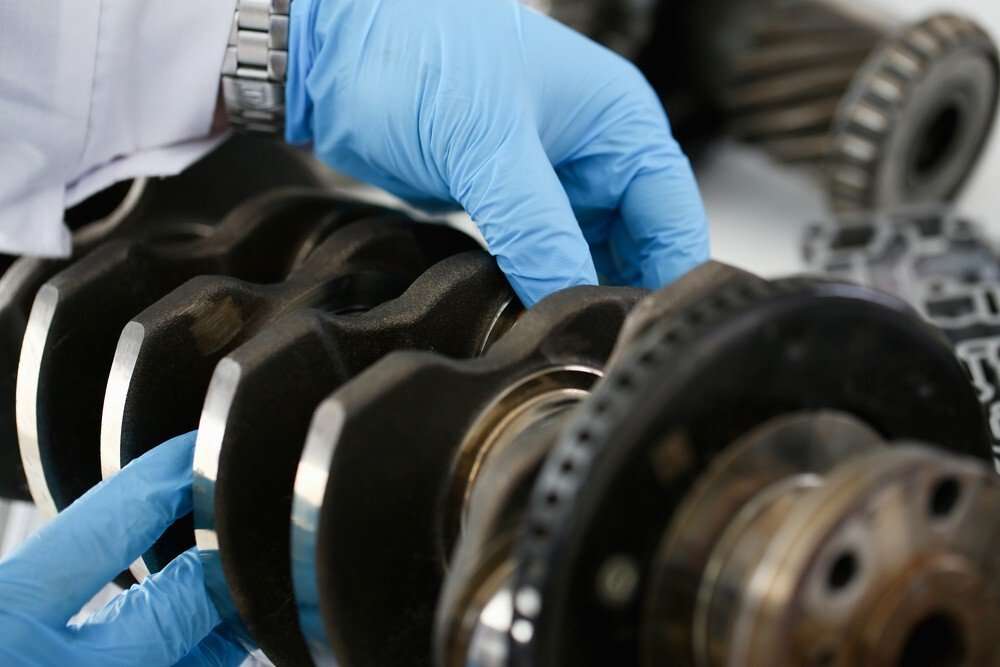It can be frustrating to start your car when the crankshaft sensor is bad. You may have tried everything and still have trouble starting your car.
Crankshaft sensors are a common part of your car’s ignition system. They can fail for several reasons, but it is hard to diagnose the problem because there are no warning signs until you try to start your engine and nothing happens.
This article will teach you how to troubleshoot a bad crankshaft sensor and fix the problem yourself. It will also teach you how to start a car with a bad crankshaft sensor.
The key is knowing when the crankshaft sensor goes bad and how it affects your vehicle’s performance. The most common symptoms of a failed crankshaft sensor are hard starting, stalling, or rough idle during the engine warm-up phase.
Jump to
- 1 What is a Crankshaft Sensor?
- 2 How does Crankshaft Position Sensor Work?
- 3 Symptoms of a Bad Crankshaft Position Sensor
- 3.1 Hard starting
- 3.2 Rough idle, stalling, or misfire during the warm-up period
- 3.3 The crankshaft sensor operates intermittently
- 3.4 Engine misfires at idle speed only
- 3.5 Engine oil consumption has increased
- 3.6 Check Engine Light On
- 3.7 Cylinder Misfire detected and Engine misfires at idle speed only
- 3.8 You smell burning or electrical smell in the car’s cabin
- 3.9 Vibration or rumbling noise is heard under acceleration or when braking.
- 4 Finding Crankshaft Position Sensor (CPS)
- 5 How to Start a Car with a Bad Crankshaft Sensor
- 6 Testing Bad Crankshaft Sensor
- 7 FAQ’s
What is a Crankshaft Sensor?
The crankshaft position sensor is an important component in the engine. It takes electrical input from sensors, including oil pressure and camshafts, to determine how fast the crankshaft is turning and sends that information to other parts of the vehicle’s control system like the engine control module (ECM) so they can adjust ignition timing accordingly.
It can fail for several reasons, but you may not know that there is a problem until your car won’t start.
How does Crankshaft Position Sensor Work?
The crankshaft position sensor is a device attached to the end of the crankcase that detects the engine’s RPM and sends this information to an engine control module.
The sensor may be located right above the ignition, so for it to detect the RPM level of the engine, it needs to have an unobstructed path of clear air.
The crankshaft sensor is usually attached to the rod that powers the crankshaft, which moves the pistons up and down.
It sends a signal back to the computer when it rotates so that the ECM knows how long each stroke of the piston takes and which direction to send current to continue firing each spark plug.
Symptoms of a Bad Crankshaft Position Sensor
Here are 9 symptoms that indicate a bad crankshaft position sensor:
-
Hard starting
The main symptom of a bad crankshaft position sensor is when you try to start your car, and the engine won’t start at all, or it stalls immediately after starting.
Your engine may have enough current running through it to turn over, but there may not be enough energy produced by the ignition system to keep the spark plugs firing for longer than a few seconds after starting.
-
Rough idle, stalling, or misfire during the warm-up period
A bad crank signal can cause an engine to stall when it enters the warm-up phase because the ECM is receiving conflicting information about how much fuel should be delivered.
The ECM may detect that the car is idling too fast, but it will not know if this is due to a normal warm-up or an indication of a problem.
-
The crankshaft sensor operates intermittently
If your crankshaft position sensor has failed, it will cause hard starting and stalling issues when the engine is cold, but after restarting your engine several times, you notice that the issue goes away until the engine cools down again then starts causing problems again. Decreasing or increasing idle rpm’s can temporarily fix this kind of issue until restarting as well.
-
Engine misfires at idle speed only
A bad crankshaft signal will prevent proper communication between the ECM and the ignition system. As a result, you will hear an abnormal engine noise when the crankshaft signal is interrupted.
-
Engine oil consumption has increased
A bad crankshaft sensor can cause your car’s engine to burn more fuel than usual, even if there are no immediate starting problems or performance issues while driving.
This extra combustion may lead to excess gas being released into the crankcase with each piston cycle, which in turn causes premature wear on all moving parts, including pistons rings and bearings, and excessive heating within the engine compartment that may also cause damage over time.
-
Check Engine Light On
The most common codes that indicate a failure of the crankshaft position sensor are P0455, P0456, and P0457. These codes often appear together with other performance problems such as rough idle, stalling, or misfires during the warm-up period, and fuel consumption increase.
-
Cylinder Misfire detected and Engine misfires at idle speed only
In this case, the crankshaft sensor may not fail, but it is sending faulty information to the ECM, which causes poor communication between the ECM and ignition system. As a result, your car will experience an abnormal engine noise when engine RPMs are low.
-
You smell burning or electrical smell in the car’s cabin
The most common symptom of a completely failed crankshaft position sensor is the burning smell that comes from the area around the ECM, which can cause small damage to other electronics in the process.
-
Vibration or rumbling noise is heard under acceleration or when braking.
You can also hear a rattling noise coming from the engine compartment that increases severity as you accelerate and decelerate or your car is braking. This vibration indicates there is an imbalance in the crankshaft position sensor.
Finding Crankshaft Position Sensor (CPS)
The crankshaft position sensor is located near the coolant recovery tank and fuel filter in the engine compartment. The crankshaft position sensor on most vehicles is near the back of the engine, but it is not always easy to see because many manufacturers use plastic covers to protect it from damage or moisture.
How to Start a Car with a Bad Crankshaft Sensor

When your crankshaft position sensor fails, and you need to get the engine started and running smoothly again as soon as possible without going to mechanics, there are a few things you can do to get your car started without replacing the sensor.
This may be the quickest and easiest way to diagnose the problem. You can use an OBD2 scanner tool, which is available at most auto parts stores for around $25, to read codes that may have been stored in your vehicle’s computer. Codes related to a failed crankshaft position sensor may include:
P0455 – Crankshaft position sensor A circuit
P0456 – Crankshaft position sensor B circuit
P0457 – Crankshaft position sensor A & B circuits
P0337 – Crankshaft Position Sensor A Circuit Low Input
P0338 – Crankshaft Position Sensor A Circuit High Input
P0340 – Crankshaft position B circuit malfunction
P0341 – Crank position sensor B circuit range/performance
P0342 – Crank position sensor B circuit low input
P0343 – Crank position sensor B circuit high input
P0351 – Cylinder 1 misfire detected
P0352 – Cylinder 2 misfire detected
-
Use a jump starter or battery booster pack
If your crankshaft position sensor fails, and you have a jump starter or battery booster pack for your car, you may be able to get things going by hooking it up to your battery and trying to start the engine.
If you have a weak or dead battery, you may get the engine to start once or twice before needing a new battery. Be sure to let the engine run for a few minutes after starting.
-
Check and clean all connections and fuses
Check that nothing is loose in the area of the crankshaft position sensor connector or transmission connector because maybe your CPS Sensor is good, but the wires to that sensor are bad, and they get disconnected when you move your engine around. Check fuses and clean them if necessary.
-
Clean corrosion from the crankshaft position sensor connector pins
Corrosion can build up on the electrical connector pins, which can cause a poor connection. Try cleaning the area around the crankshaft position sensor with an electronics or carburetor cleaner spray to remove any corrosion. If that doesn’t work, you may want to replace the connector.
-
Replace the sensor
If cleaning and checking fuses do not fix the problem, you can simply replace the sensor. This is not an easy job, and if you are not DIY-savvy, you will need to tow your car to a shop for repair. The CPS sensor costs around $100, but installation can cost between $200 to $300.
Testing Bad Crankshaft Sensor
Using Multimeter:
The crankshaft position sensor can be tested with a multimeter. First, you will need to remove it from the engine. Then connect one lead of the multimeter to the ground and touch the tip of an alligator clip to each wire terminal in turn.
If your reading is more than 0 volts but less than 5 volts, your sensor is fine. If your reading is more than 5V, then the crankshaft position sensor requires replacement.
Diagnosing a bad crank sensor with an oscilloscope:
An oscilloscope can be used to test a crankshaft position sensor. The crankshaft position sensor will trigger the ignition coil, which will produce an impulse signal. The suggestion is to check the duty cycle and the number of ignition peaks at a certain time interval. If the crankshaft position sensor is bad, then these two parameters will change significantly.
To test if your crank sensor has failed or not, you can do this test. This is a good way to check if the crank sensor is bad without removing it from the engine.
FAQ’s
1. Can a car start with a bad crankshaft sensor?
The crankshaft position sensor is a crucial aid in ensuring that your car’s engine can fire up reliably and without issue. If this important component begins to experience problems, it may result in erratic starting or even complete failure of the motor – making sure it remains healthy should be at the top of any driver’s priority list.
2. Which sensor can stop car from starting?
A faulty crankshaft position sensor can be an underlying cause of engine stalling; it tells the computer when to ignite spark plugs, so a malfunctioning one will overwhelm your vehicle’s system leading to ignition troubles. Make sure you check this part if anything seems off with your car.
3. What happens when a crankshaft sensor doesn’t work?
A faulty CKP sensor can leave your engine feeling like it’s shaking or stuttering, particularly when under a load – this is referred to as misfiring. The culprit? Your PCM has been tricked into miscalculating fuel injector pulse and spark timing because of the errant sensor.
4. Can I drive my car without a crankshaft position sensor?
If the crankshaft sensor in your car stops working, you should take action immediately. Ignoring this issue could be dangerous and lead to costly engine damage down the road. Don’t wait—get it fixed as soon as possible.
Conclusion
In this guide, we’ve talked about the symptoms of a bad crankshaft position sensor and how to start a car with a bad Crankshaft Sensor.
We hope that you were able to find an answer for your car troubleshooting issue from our comprehensive list of potential causes or by using one of the actions outlined in our repair guide.
If not, contact us and let us know how we can help you out. Our team is always happy to lend a hand when there are questions about automotive maintenance.

My name is Tom Harris, founder of this blog. I’m a mechanical engineer with 20 years of experience in the automotive industry. I’m here to help you with your vehicle’s problems, easy fixes and share my insights and experience so that you can enjoy your rides more.

